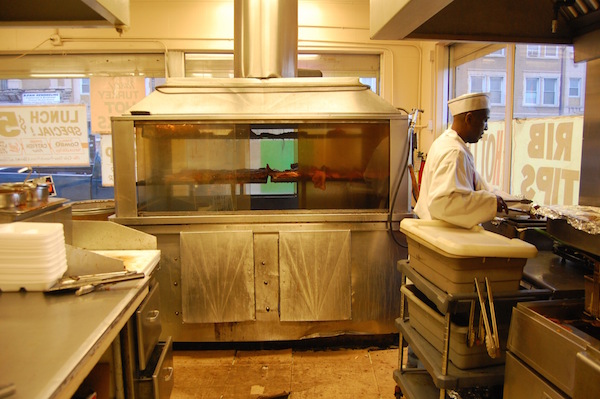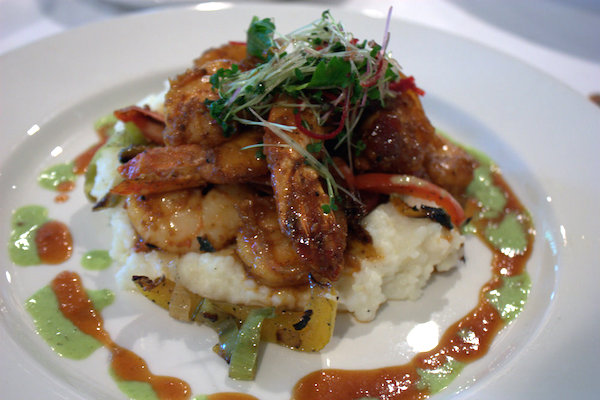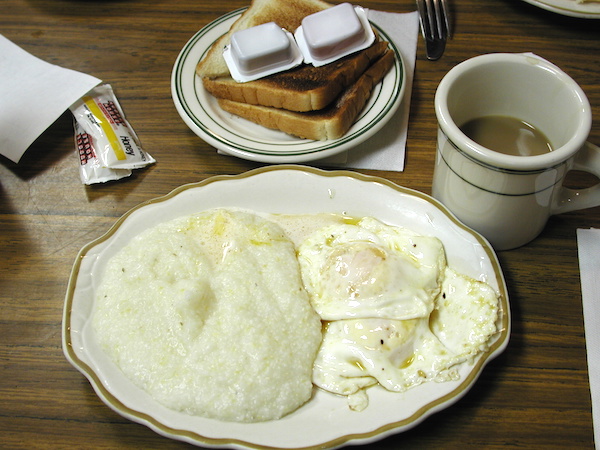True Grits: A Sandlapper Heritage
“The first great fortunes in the colony of Carolina were made with rice—by the labor of countless enslaved Africans who brought with them the engineering and agricultural knowledge that made the rice crop so productive. Corn, however, was a gift of the native peoples of the colonies . . .” —William A. Balk, Jr
Epicurus’ Porch
By William A. Balk, Jr
BEAUFORT South Carolina—(Weekly Hubris)—08/17/2015—Claims to “Heritage” have been much in the news recently, and those born in any culture and raised to know that culture’s history will understand the complexities such knowledge reveals.
I was born in the American South, although the distinction of having been reared in South Carolina—a Sandlapper—was of more significance to how one defined oneself than was the more generic “Southerner.” I suspect “Sicilian” more correctly reflects the identity of someone from Palermo than does “Italian.” It’s the same for me.
I’ve read a bit; I’ve traveled a little and lived in places beyond the boundaries of my native soil. I’ve found friends from exotic places with even more exotic lives. I am painfully intimate with the weighty baggage my heritage brings and which accompanies me everywhere.
There are aspects of my heritage—utterly inseparable from all the other parts of that heritage, intricately entwined with the darkest forces at work through that history—which can elevate the conversation, can bring communion among disparate communities, can feed the very soul. There are several such enriching aspects of my shared Carolina roots, but perhaps the most enriching and most joyfully celebrated are the culinary traditions of our state.

American corn—maize, to much of the rest of the world—and rice, the lower-starch, long-grained type called “Carolina” rice regardless of its origin, are the ruling grains of our cuisine. One or both traditionally have appeared at every meal, it is said, in a South Carolina household.
The first great fortunes in the colony of Carolina were made with rice—by the labor of countless enslaved Africans who brought with them the engineering and agricultural knowledge that made the rice crop so productive. Corn, however, was a gift of the native peoples of the colonies; it sustained generations of natives and provided sustenance for the colonists of every station; it may, therefore, lack the regal connotations of Lowcountry rice.
Fresh corn was roasted, boiled, or fried, both on and off the cob. It was cooked with milk as creamed corn or as a soup. The dried grains could be stored for lengthy periods—assuming they could be kept from the depredations of vermin—and used when fresh corn was unavailable. Corn was ground for hoe cakes and corn bread.
The native peoples had discovered that soaking the dried kernels in an alkaline solution, such as that made with wood ashes, changed the corn by expanding the kernel, shedding its hard coat, and increasing the digestibility and nutrition of the grain. The result, called by a native name for maize, hominy, was a staple of native and colonist cuisine.
But the queen of corn dishes is what I grew up calling “hominy grits,” and what is simply called “grits” by most people today. In those days, we would buy grits, dried ground corn, and serve it cooked for breakfast or supper. Once cooked, the dish was called hominy, still using the old native name for corn or maize.
Most of us who grew up in the South are affectionately familiar with hominy or grits. People from away, not from the South, seem to have a very different relationship to grits—many seem to abhor it. And I think I may know why.
Getting a decent plate of grits at a less-than-two-star restaurant is a rarity. Although nothing could be easier to make than a respectable pot of grits, it would appear that such minimal skill is beyond the capacity of most eateries. The exception these days is, of course, the new restaurants serving twenty-dollar grits. Those chefs do make fabulous grits, I admit.
But small local eateries should be able to make inexpensive, quite delicious grits from readily available ingredients, and every home kitchen able to prepare excellent grits from the same simple ingredients using only the simplest of techniques.
People who dislike grits do so, I believe, because they have been served some of those ubiquitous white slurries of tasteless glop cooked up in lesser restaurants (and certain fine ones, as well) across the South.
If you want to try some quite good grits, made from standard grocery store packaged grits, find a package of “quick” grits—definitely avoid “instant grits” —and, if you can, select a package with a coarse grind. “Regular” grits will have a coarser grind than “quick” or “instant.” Yellow or white makes no difference in preparation or taste, although I am fond of the rich color of yellow grits. Read the directions on the package; they’re a good starting point.
Basically, the recipe is to measure perhaps a quarter-cup of raw grits per serving, and cook them in four times as much liquid as raw grits. Four-to-one: that’s the magic ratio. However, I think a far more delicious result, and one with a much, much better texture, may be made by initially cooking with a reduced amount of liquid. More liquid may be added later for an absolutely perfect texture.

Here’s what I like to do for excellent basic grits: for four servings (I love good hominy, so I give myself two servings), measure one cup of “quick” grits. Grits with a coarse texture result in a more toothsome dish. No soaking is necessary for “quick” grits.
In the upper pot of a bain marie or double boiler, bring to the boil three and a half cups of your preferred liquid—in most cases, I use water for this first stage, although milk, stock, or other flavored liquid may be used. It should be salted to taste, especially if you’re using water, unless you want to end up with an utterly tasteless gruel; and I will usually add about a half teaspoon of salt at this stage.
Pour the raw grits into the boiling liquid and bring to a simmer while stirring constantly. Remove the grits from direct heat and place this upper pan over—not in—steaming water in the lower pot of the double boiler, and keep it over a low flame. “Quick” grits will thicken considerably within ten minutes or so, and the double boiler prevents clumping or scorching as it thickens and cooks with an occasional stir.
At the point that the grits have thickened and become a bit too stiff, I thoroughly stir in small portions of more liquid. For breakfast hominy, I will use dairy half-and-half, a few tablespoons or as much as a quarter cup, even more if the texture calls for it, stirred in thoroughly as the pot of hominy nears complete doneness. (Tasting is useful here, so the cook may judge correctly the degree of firmness of the corn grains and the balance of tastes.)
During fresh corn season, I will add several tablespoons or more of fresh corn juice and kernels stripped from the cob. This will elevate the hominy enough to inspire awe for the cook’s expertise.
My grits are cooked until tender-but-firm grains satisfy the mouth; they are prepared thick enough to serve on a plate instead of requiring a bowl, although a bowl is fine. For breakfast, they are often accompanied by a slathering of butter, by a gravy made from sautéed ham, or by a wonderful hash we make from pork, vegetables, potato and copious amounts of its sauce—all served over the hominy on the plate.
Hominy grits are never served with sugar.
This is a basic, delicious, simple, and inexpensive preparation for hominy grits; it is a method which lends itself to a number of variations by using more savory liquids for the cooking or by serving the hominy with sauces or seafood or meats or cheese. (My childhood favorite breakfast was to crumble bacon into my grits and stir: wonderful!)
Now, it should be noted, culinary historians, farmers, and chefs such as Michael Twitty, John T. Edge, David Shields, John Martin Taylor, Sean Brock, Glenn Roberts, and numbers of others are not only finding out how our ancestors prepared these treasured old recipes, they are earnestly finding and bringing back into production the original plant breeds.
The demands of industrial agriculture and modern preparations have erased from production many of the most delicious and useful of the old foodstuffs: some are now completely lost; others discovered existing as only a row or two on a single farm. Thanks to these saviors, we now have available once again Carolina Gold rice, the Bradford watermelon, and John Haulk dent corn among another “lost” tastes.
The “benne” of our ancestors, an African staple brought aboard slavers’ ships, was utterly unlike the sesame-oil seed sold now. That, too, has been rediscovered and revived and, once again, we can taste true benne flavor, celebrated for centuries but an unknown taste to modern palates.
These older, rarer, artisanal foodstuffs often require different preparation than their newer counterparts, but the results are justly touted as transcendent.
To make a pot of hominy grits using the artisanal dent corn from Anson Mills, plan on soaking the grits overnight in water. The cooking time will be shortened to 45 minutes to an hour if soaked; whereas, without soaking first, you need to plan on at least an hour and a half of cooking.
To cook coarse stone-ground grits from the grocery store, soaking overnight is also useful. The cooking time is reduced somewhat, from about an hour without soaking to about a half hour with soaking.
Before beginning the actual cooking, strain off the chaff, which will have floated to the surface during the soak.
The ratio of grits to water or liquid is essentially the same four-to-one as in the original recipe, but these coarser grinds will absorb a bit more liquid. For the store-bought, stone-ground grits, I follow the basic recipe above for “quick” grits, but I plan ahead to add more half-and-half or milk at the end of the cooking to make sure I get the texture and thickness I want.
Preparing grits from basic store-bought “quick” grits can alter the way one thinks about this classic, sometimes maligned, dish. Preparing grits from an artisan miller, using the old varieties of corn, ground a bit coarser, and using these long and slow cooking methods will leave one swooning with pleasure.


Basic Hominy Grits (for four)
1 cup “quick” grits
3 ½ cups water
½ tsp salt
In the top part of a double boiler over direct heat, bring salted water to a boil; add raw grits to boiling water, stirring vigorously, and bring to a simmer. Place pot of grits over steaming water in lower part of double boiler, stir, and cover. Cook for 15 to 20 minutes, stirring occasionally to prevent lumps. When the grains are almost soft and the grits are stiff and thickened, stir in additional liquid to taste, adding by the tablespoon. Use milk, half-and-half, stock, corn juice, or water. Add enough to thin the grits for serving, but thick enough to make a toothsome forkful. Serve with butter and salt, with crumbled bacon, with meat hash, or with gravy.

Coarse Hominy Grits (from an artisan miller, for four)
Cooking time: soaked overnight, c. 50 minutes; unsoaked, c. 90 minutes
1 cup coarse artisanal grits
5 cups spring water
Fine sea salt
2 or 3 Tablespoons unsalted butter
Pepper
In the upper pot of a double boiler, measure 2 ½ cups spring water. Add 1 cup grits and let sit for 1 minute. Stir once, tilt the pot, and skim off the chaff with a tea strainer. Set aside to soak overnight. If not soaking the grits, proceed with the cooking.
Place the pot of grits over medium heat and, stirring constantly, gently heat until the grits begin to thicken: 5 to 8 minutes. Immediately place pot over lower pot of steaming water and cover the grits. It is important to keep the grits from reaching the boil—the pure sweet corn flavor depends on it.
Meanwhile, have 2 or 3 cups of water in a small pot kept hot nearby. About every 10 minutes, stir the grits and check their thickness. When they are thick enough for a spoon to stand up in them, add a small amount of hot water and stir into the grits. You will add 1 ½ cups or so over 4 or 5 additions. About halfway through the cooking, add a half teaspoon of salt
In about 50 minutes, if you soaked the grits, or in about an hour and a half if they were not soaked first, they should be creamy, tender throughout, but not mushy. They should hold their shape on a spoon.
To finish, stir in the butter, adjust salt and add pepper to taste.

Note: The first image above derives from the Southern Foodways Alliance via Wikimedia Commons; the second photo is by Krista, also via Wikimedia Commons; the third photo is by Pollinator, also via Wikimedia Commons.


8 Comments
Elizabeth Boleman-Herring
It’s a terrifying factoid, but Dean JUST got good grits at . . . shudder . . . Cracker Barrel. Hey, we live in the absolute sticks, Will! Cracker Barrel is about as good as it gets around here. No segue. I dined at one of Manhattan’s 5-star eateries back in c. 1999, and was served grits containing stones. The waiter offered to do precisely nothing when informed by the two South Carolinian diners that THIS WOULD NOT DO. I believe the bill came to c. $800. I was FURIOUS. It’s very, very hard to get the little things precisely right but, oh, when one does. When one does. One of my grand-somethings was a miller in Anderson County and produced Smith Corn Meal and grits. Next time I’m up that way…. Thank you for this wonderful essay!!!!
Anita Sullivan
Yumm! Thanks, Will, for reminding me that I used to like grits before I left the South. Maybe Bob’s Red Mill Flour Company out here in the Oregon boondocks sells it. What a culinary treasure indeed!
Will
EBH, I constantly hear adulatory comments from knowledgeable friends about Cracker Barrel’s grits and several other items on their menu. I don’t eat there due to remnants of boycotty recollections of their boorish treatment of a certain class of clientele, but that they can do decent grits is an ameliorating factor, for sure. I think now anyone in Manhattan serving grits would be too ashamed for the dish NOT to be perfect.
Will
Thank you, Anita….you know, I’m almost certain Bob’s Red Mill does package a stone-ground version of grits, which, if I remember correctly, is labeled Stone Ground Corn Grits/Polenta. A very good product. Definitely worth searching out.
Diana
Grits is something I never learned to appreciate, but you make it sound as though I’m missing something terrific. Alas, don’t think grits can be found anywhere in fair Hellas but I’ll look when I get back to Athens. Loved the story. As always.
Lolita
Huddle House!! I recognize that coffee cup!! (and actually, they’re grits aren’t TERRIBLE…just not as good as home-cooked!)
Loved the writing, Will…from grits to gardening, you’re on it!!! And I just don’t GET what there is to NOT like grits…grits are like biscuits, Mom made the best ones but I keep trying to get it right!! Thanks for sharing your “expertise!”
Will
Ah, Diana. Maybe there’s a market for quality grits in Athens! Or an upscale Huddle House a la Lolita’s observation above, serving stone ground, artisan grits. I must say, given the poor quality of much of the grits I’ve been served over the years, it’s hardly surprising you never developed a taste for the dish. We can fix that!
Will
Lovely Lolita, I know you know whereof you speak. I hear rumors of the fine level of cuisine available at your riverfront banquets, and Jon makes a mean pot of shrimp and grits from what I hear. Thank you -as always – for reading the pieces, and especially for sharing your thoughts on them.